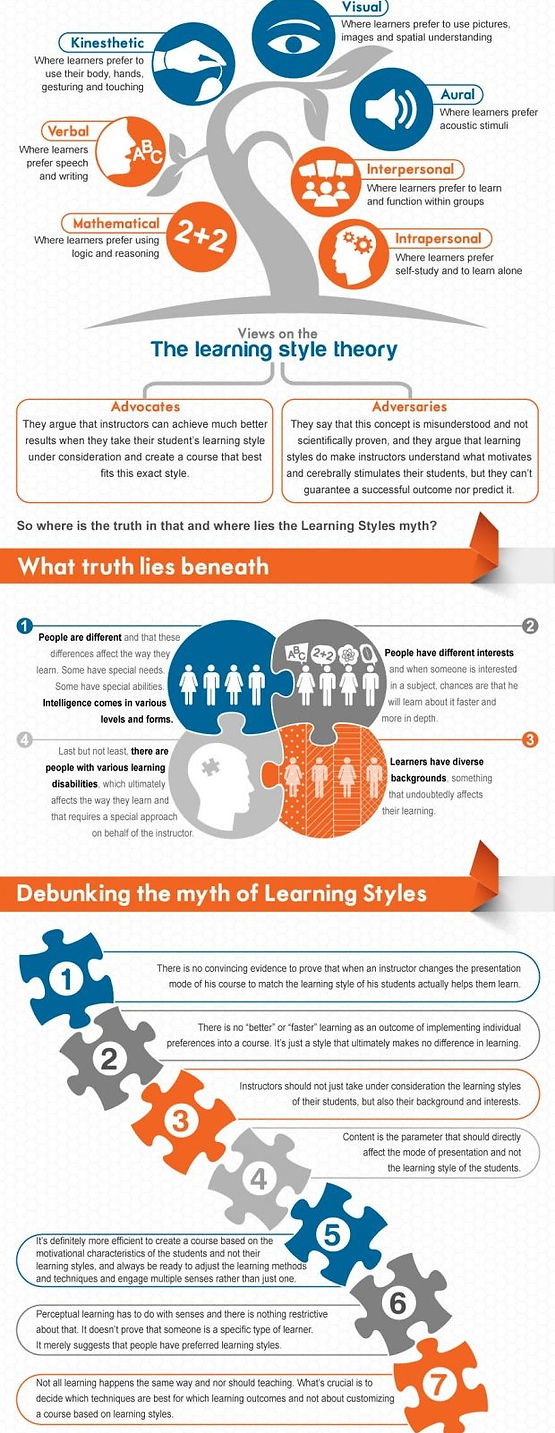

Pros and Cons of Learning Styles Theory




Benefits of the learning style theory:
Even though there is little evidence to support the learning style theory, some teachers still use the concepts of this theory within their classrooms. By knowing which way your students learn best can be beneficial.
When determining a student’s learning style it is often times referred to as their “preferred” way of learning. This implies that everyone has a natural tendency towards learning of some sort and that can be identified as their preferred learning styles. As a teacher, knowing which way each student feels most comfortable learning can be useful to provide help so that the student can learn and understand more effectively. (“Research Summary,” n.d.)
Questions to consider when determining a child's preferred learning style: (Powell, 2011)
-
What are the child's strengths as a learner?
-
Under what conditions have you seen the child doing his or her best work?
-
What are you noticing about the environmental influences on this student's learning?
-
What activities does the child engage in after school or during recess?
-
If the child were to design a field trip, what are your hunches as to where he or she might choose to go?
-
What have you noticed about the child's preferred learning styles or intelligence preferences?
-
In what ways does this student most prefer to demonstrate learning?
Benefits of identifying a student’s learning style according to Judith C. Reiff’s (1992) book Learning Styles. What Research Says to the Teacher Series are:
Reducing Frustration for students and teachers
Improving Self-Concept and Achievement
Helping the teacher plan and manage the classroom
Increase in Variability and Flexibility
Improvement in Communication
[This video provides additional insight for teachers on how to understand and incorporate a student's preferred learning style into the curriculum.]
We know that every student learns a bit differently, by using their preferred learning style to understand the information will boost their confidence and help them feel more comfortable about learning. As a teacher, knowing students preferred learning styles will help when preparing a lesson plan, altering it around a certain style. We know that students are more comfortable learning using their preferred learning styles, but this also gives the teacher an opportunity to expand their learning styles and present information in various ways, allowing students to perform out of their comfort zones.
Cons of the learning style theory:
-
There is no definite scientific evidence to support it.
-
Teachers are using the information incorrectly and forcing children to focus on one specific learning style.
-
Students learn using all of the methods of the learning style rather than one specific one.
-
Willingham, an expert in the field of cognitive psychology, states that it is an ability to do something better not a learning style. Click Here for More Information!
-
Industries have taken advantage of individuals lack of knowledge and have made many products to make learning styles more appealing to teachers “an entire industry has sprouted based on learning styles. There are workshops for teachers, products targeted for the different learning styles, and schools that even evaluate students based on this theory.” For more information Click Here!
-
It is important to see how students learn best which may involve more than one specific way of learning. Working with their similarities may be more important than teaching towards their differences. Providing access to all learning styles can reach students on mulitple levels and create a deeper meaning.
-
Willingham speaks about how he believes that people mistake evidence of learning styles for evidence of ability, as stated on his website. “I think that often when people believe that they observe obvious evidence for learning styles, they are mistaking it for ability."
-
For frequently asked questions of Willingham Click Here!
An example to better understand the cons of the learning style theory:
A teacher believes his or her student to be a visual learner. He or she might introduce the concept of simple addition using pictures or groups of objects, manipulating the objects to demonstrate the process. The teacher is assuming that the child will learn best through this approach. Through the teachers beliefs of this theory they beleive the visual approach will work best, rather than simply listening to a lesson about addition or doing anything kinesthtically with addition. The truth is that the student may have gained a deeper meaning and connection with addition, if it was introduced in more than one way. If we just focus on one way of learning it will put children at a downfall.
For a full version of Willingham's video Click Here!

Views on the Learning Style Theory-